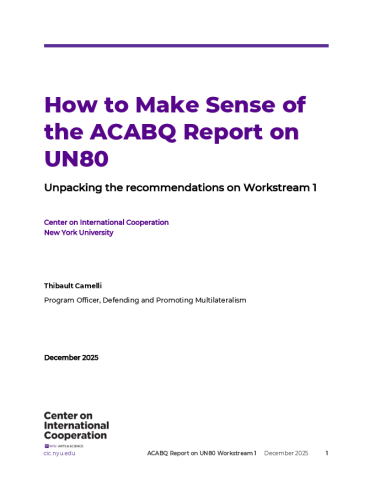In this book, UN Peacekeeping Doctrine in a New Era: Adapting to Stabilisation, Protection and New Threats, edited by Cedric de Coning, Chiyuki Aoi and John Karlsrud, the contributors examine the new challenges facing UN peacekeeping operations and question whether it is necessary for the UN to revise its doctrine to reflect the way peacekeeping has adapted to these challenges on the ground. CIC Visiting Scholar Alexandra Novosseloff, herself a contributor (with Thierry Tardy) to the edited volume, together with GPOR’s Editor-in-Chief Jim Della-Giacoma recently spoke to de Coning about what needs to change.
Alexandra Novosseloff (AN): What is the new era in peacekeeping doctrine that you describe?
Cedric de Coning (CdC): In the book we have analyzed the last decade’s peace operations, in particular those that we think may have gone beyond the existing 2008 UN Capstone doctrine. We did not deal with those operations where the UN is assisting with the implementation of a peace process, as these operations do not pose a doctrinal challenge. We organized the rest in three typologies. In the first category, we address those missions that helped to establish new states, namely Kosovo, Timor-Leste, and South Sudan. In the second, we dealt with operations that have a protection of civilians mandate amidst ongoing conflict, like in Darfur and South Sudan. In the third, we analyze stabilization operations which we frame as missions where the UN is tasked to protect the government and its people against an insurgency or identified aggressors. We argue that these three types of operations – the latter more so than the former – place a strain on the existing 2008 Peacekeeping Capstone Doctrine and the core principles of peacekeeping. In particular, we argue that the widening gap between the actual practices of these operations and the existing consensus on what UN peacekeeping is and is not, as captured in the principles and doctrine, is creating a series of new problems and challenges.
AN: I noticed that you are talking about the traditional versus what could be considered more modern types of peacekeeping operations. Is this an actual division or are more recent peacekeeping operations just examples of how the UN is adapting to the evolution of conflicts, new environments, and the needs of international community in dealing with them?
CdC: Twenty years ago two thirds of UN peacekeepers were deployed in operations where the UN was implementing comprehensive peace agreements in places like Angola, Mozambique, Namibia and Cambodia, and more recently in Sierra Leone, Liberia, and Burundi. Today two thirds of peacekeepers are deployed amidst ongoing conflict. The principles and doctrine is based on the assumption that a cease-fire or peace agreement is a precondition for considering the deployment of a UN peacekeeping mission. This shift away from using the UN as a tool to keep the peace, towards using the UN to protect civilians amidst ongoing conflicts, or to protect governments from insurgencies, pushes UN peacekeeping beyond the principles of peacekeeping and existing doctrine.
AN: Indeed, but can we really compare the missions of the past with those of today? Or if we can, should we see the difference more as the evolution and adaptation of the UN to the new challenges instead of saying that then we had “traditional” peacekeeping and now we have “new” peacekeeping?
CdC: There has been significant adaptation and evolution in UN peacekeeping over the years, but we argue that what we are now witnessing is approaching a tipping point. The High-level Independent Panel on Peace Operations (HIPPO) panel’s report notes that 98 per cent of peacekeepers are currently deployed in missions with a protection of civilians mandate. Two thirds of these missions are what the HIPPO report refers to as ‘conflict management’ missions, i.e. missions where there is no peace agreement in place. In this latter category we have paid special attention to UN stabilization operations, where the UN Security Council has tasked the missions in the Central African Republic (CAR) and Mali to extend state authority, if necessary by force, and in the Democratic Republic of the Congo (DRC) to “neutralize” identified armed groups. In these cases, the UN missions does not have the consent of the parties to the conflict, only that of the host government. The UN missions also can’t be said to be impartial towards the parties to the conflict, as they are acting to protect the governments against specific parties identified as aggressors by the Security Council. In some cases, the UN missions are also operating alongside the security forces of the host government in joint operations against the identified aggressors. In our analysis, these developments go beyond the outer limits of the existing principles of peacekeeping.
Jim Della-Giacoma (JDG): But do you still draw a difference between the robust use of offensive force and defensive force? What other changes are taking place?
CdC: The most significant departure from existing doctrine has been the authority given to the Force Intervention Brigade to employ offensive force on an operational level to neutralize the M23 and other armed groups in eastern DRC. In CAR and Mali the mandate is still framed in more defensive terms, but there we also note that the forces are encouraged to take proactive steps to protect the government and the people against insurgents and aggressors, and in both cases these missions have on occasion proactively used deadly force to protect civilians or themselves. In Mali, the UN is facing armed and terrorist groups that wants to do it harm, and in those circumstances the mission has to adopt a different posture then one would expect in a mission where the parties to the conflict has consented to the role of peacekeepers. For instance, in Mali the UN peacekeeping missions makes use of intelligence, is instructed to proactively use force, and at times move around with stealth, using camouflaged rather than the usual white painted UN vehicles. In the concluding chapter by Chiyuki Aoi and myself, we raise the question whether the UN should consider a new doctrine when it comes to stabilization operations. We argue that making a clear distinction between UN peacekeeping operations and UN stabilization operations will, on the one hand, protect peacekeeping as a distinct tool with its own principles and doctrine, and on the other hand it will help to ensure that when the UN Security Council tasks the UN Secretariat to deploy a stabilization operation, that it is clear to all stakeholders what the task entails, so that such a mission can be planned and deployed with the appropriate troops, capabilities and preparation.
AN: But is stabilization only the responsibility of the UN? Also we know stabilization is expensive and the annual cost of 16 UN peace operations was the equivalent of one month of NATO’s stabilization mission in Afghanistan at the height of operations there. If stabilization is going to be more expensive, do we need to re-examine the way UN operations are funded and not just their doctrine?
CdC: Our findings are consistent with the HIPPO report. We agree with the HIPPO report that the UN should not do peace enforcement or counter-terrorism operations. We agree that regional arrangements or coalitions of the willing are better suited for such operations. However, we observe that despite the Brahimi and HIPPO guidance, and regardless of the consensus that exist around the core principle of peacekeeping, and the broad acceptance of the 2008 capstone doctrine, the UN Security Council has authorized the UN to undertake stabilization operations in the three cases mentioned in Africa, including offensive operation in the case of FIB. The FIB is widely regarded as a success by members of the Security Council and several other countries. These operations also solved other important challenges, such as how to finance and support African-led peace operations and how to avoid or manage the parallel deployment of two or more forces in the same theatre of operations. For these reasons, we think that it’s likely that the Security Council may continue to authorize such operations under UN auspices. Aoi and myself are not advocating for UN stabilization operations, but we are saying if the Council continues to task the UN to undertake such operations, then the UN should consider if it will not be more effective if it has a doctrine that is more suited to the stabilization task. We argue that doing stabilization with a peacekeeping doctrine and mindset has had sub-optimal results to date. It has prevented the UN from protecting civilians more effectively and it has resulted in the highest number of peacekeeper casualties in 20 years.
AN: But if the UN is conducting these two different types of operations, isn’t there a risk of having some confusion, especially on the ground? Are the troop contributing countries (TCCs) ready to send their personnel to stabilization missions? And are the financially contributing countries (FCCs) ready to fund those operations?
CdC: What we are describing in our book is the actual practices that have occurred over the last decade and a half. We observe that doing stabilization with a peacekeeping doctrine and mindset has caused confusion on the ground. The gap between the existing doctrine and current practices in places like Mali, CAR, and DRC is too large. The troop contributing countries, the Security Council, the Secretariat, and the host nations do not have a shared understanding of the role and tasks of these missions. Some countries, especially the Europeans in Mali and some African countries in the DRC, are comfortable with missions that have a stabilization mandate and have been prepared to deploy their troops to these missions. Other countries still believe that they are deploying to traditional UN peacekeeping operations when they send their troops to CAR, the DRC or Mali, and they prepare and deploy their troops accordingly. When it comes to cost, the UN Security Council has authorized the stabilization operations in Mali, CAR and the DRC, despite their costs. Perhaps this may change under the financial pressure that is now coming from the Trump Administration, but on the other hand the impression one gets is that the Trump Administration will be more willing to fund UN operations that have a counter-terrorism orientation, than those that implement a peace agreement or protect civilians. It is thus not necessarily obvious to me, from the UN experience over the last fifteen years, that it will be more difficult to find funding or troops for stabilization missions.
AN: Are you are advocating for a better division of labor in crisis management recognizing the comparative advantages of different international organizations? Are you arguing for the UN to do peacekeeping and other coalitions, countries, or organizations should be responsible for military stabilization operations?
CdC: We are not advocating for a specific policy direction. We are identifying the challenges, and pointing out the problems or dilemmas with different policy choices. We agree with the HIPPO guidance that the UN should not do peace enforcement and counterterror operations. We also agree with the HIPPO that the UN need to clarify what stabilization means in the UN context. What we observe however, is that the Security Council has authorized UN stabilization operations in the past, and is likely to continue to authorize such operations, regardless of the HIPPO panel recommendations or the preferences of the UN Secretariat or some TCCs.
JDG: We have been talking about stabilization missions and your argument for a new doctrine, but does the book make a similar argument regarding transitional administrations or those missions with a protection of civilian (POC) mandate without a peace agreement?
CdC: Transitional administration mandates, where the UN has executive authority and responsibility, go beyond the boundaries of UN peacekeeping. This is a very challenging topic that needs further exploration, especially now that the issue of trusteeship is being raised in the context of South Sudan. The requirement to protect civilians amidst ongoing conflict, in situations without a peace agreement, has forced the UN to operate on the edge of the limits of its doctrine, and in the case of stabilization missions at times over the edge, but for the most part the UN has been able to find ways to maintain consent, impartiality and the minimum use of force. Some would argue that these compromises have come at too high a cost. In South Sudan, and elsewhere, the perception is rather that the UN should be more robust and more proactive in carrying out its protection mandate. This is especially challenging when there are armed forces or proxy militias associated with the host state, that pose a risk to civilians. This latter dilemma, which juxtapose the need for consent of the host state against the mandate to protect civilians, regardless of the source of threat, is not adequately addressed in the current doctrine or guidance. Overall, the shift in focus to protection in the late 1990s have resulted in the current situation where two thirds of UN peacekeepers are deployed in conflict management operations, and this has changed many aspects of UN peacekeeping. For instance, we observe that conflict management missions like the missions in the DRC and Darfur are not linked to a political settlement agreement and thus lack a clear political exit strategy. As a result they end-up staying in place as long as there is a need to protect civilians and as long as there is a risk of relapse.
In an Ideal World the UN Should Not Be Doing Stabilization Operations. However, the Security Council Continues to Send UN Peacekeepers on Missions Where There is No Peace to Keep, Despite the Advice from the Brahimi and HIPPO Panels.
JDG: Consent of the host country is a challenge in all missions. Will a new doctrine help resolve this very political issue?
CdC: Doctrine can’t solve specific political problems, but it can serve as a guide to prevent the UN from becoming trapped in situations, because it has used the peacekeeping instrument to try to manage situations that is was not designed for. In all the stabilization operations, we don’t have consent from the parties to the conflict in the classical sense, i.e. where the UN is implementing a cease-fire or peace agreement that all sides have agreed to, and where they have requested the UN to be the neutral third party that is assisting them in the process. In stabilization operations, the only consent is the agreement with the host government. This is a very different form of consent than what was intended with consent as a core principle of peacekeeping, or as it is foreseen in the capstone doctrine.
JDG: Earlier you alluded to the need for better triangular cooperation between the Security Council, Secretariat, and TCCs. What role do you see for the TCCs in the development of a new doctrine of stabilization?
CdC: We haven’t really gotten into the details of a potential stabilization doctrine because in our concluding chapter, Professor Aoi and I, are suggesting that the UN should start thinking about whether such a doctrine would be useful. We have not reached the point of suggesting what such a doctrine could look like. But what we have observed at this stage in the TCC chapter is that some TCCs are more comfortable with the stabilization than others. What we find in the stabilization context is that those TCCs who are willing to contribute to a stabilization operation, and who are thus willing to face potential combat, typically have a strategic or political interest in the conflict, for example SADC in eastern DRC, or Europe in Mali. This is very different from traditional peacekeeping, where TCCs are expected to be disinterested, and where having a link to a conflict may disqualify a specific TCC from being considered for that particular mission. Another consideration for European nations, as a result of their experiences in Bosnia and elsewhere, are that they are more willing to deploy into a situation where they have the authority and capability to use force to protect themselves, and this is why they are deploying with their own enablers such as attack helicopters as well as transport helicopters that are able to do medical evacuations under combat conditions.
AN: In Mali, it is certainly the case, but the Europeans are really reluctant to engage under the UN flag. This creates a two-tier operation that is very difficult to manage and where the end state is not very clear. And I am wondering if it would have been simpler for the UN and some TCCs to just have had a more modest UN operation that did the political work necessary to engage the parties to comply with the peace agreement and to have alongside that a military operation in the form of a coalition of the willing that would engaged in counterterrorism or robust stabilization?
CdC: If the AU mission in Mali had remained in place, perhaps with a more robust counter-terrorism mandate, that would have enabled the kind of division of tasks that you describe. However, for financial, support and political reasons the Security Council tasked the UN to take over the mission. What we observe is that the UN Security Council has not chosen to undertake stabilization operations in CAR or Mali, or to deploy the FIB in the DRC, because it thought that the UN should do stabilization operations, but rather because that was what, given the alternative options, was financially and politically feasible. Tasking the UN to do stabilization was thus not a choice driven by doctrinal considerations, but what we point out is that it has doctrinal implications, and these implications impact on the ability of the mission to achieve its mandate, to protect civilians and to protect itself. The division of work you are describing may also be the exit strategy for the UN in Mali, as I understand that the AU and UN is considering the feasibility of some kind of African-led counterterrorism mission in northern Mali.
AN: Is it not also a matter of having a more balanced relationship between the Council, Secretariat, and the TCCs? In recent years, the Secretariat has been unable to stand up to the Council.
CdC: In the past the Secretary-General, senior managers in the Secretariat, and many in the Security Council were deeply committed to the core principles of peacekeeping, and they tried to protect peacekeeping as an institution from overreach and over exposure. I think that has changed, and now many members of the Security Council, and even some senior managers in the Secretariat, are more concerned about appearing to be assertive in the moment, than about being consistent with the principles of peacekeeping or with UN peacekeeping doctrine. As you may recall, the ability of the M23 rebels to capture Goma in eastern DRC, which was also the HQ of the UN in Northern Kivu, was highly damaging to the credibility of the UN. Equally, if not more, damaging was the ongoing rape and murder of civilians, despite the UN presence in the region. These circumstances have made the Security Council, the Secretariat and some TCCs, especially those in the region, more willing to experiment with more robust, and even the offensive use of force. Some TCCs seem to be going along with that, whereas other TCCs are still strongly adhering to the core principles of the peacekeeping. As pointed out earlier, those TCCs that come from the immediate region, for instance those from the G-5 Sahel countries in the case of northern Mali, or the IGAD countries in the Horn of Africa in the case of South Sudan, or the countries from central Africa in the case of CAR, and the SADC countries in the case of the DRC, tend to be more willing to use force than those from further away, that have deployed under the expectation that they are contributing troops to a peacekeeping operations. There has also been a number of recent notable exceptions to this general trend, for instance, Mongolian troops in South Sudan and Portuguese commandos in the Central African Republic have both recently used forced in order to protect civilians.
Cedric De Coning is Senior Researcher at Norwegian Institute of International Affairs (NUPI) and Senior Advisor for the African Centre for the Constructive Resolution of Disputes (ACCORD). | Twitter: @CedricdeConing
Alexandra Novosseloff is Visiting Scholar at the Center on International Cooperation | Twitter: @DeSachenka
Jim Della-Giacoma is the Deputy Director of the Center on International Cooperation and Editor-in-Chief of the Global Peace Operations Review. | Twitter: @jimdella



